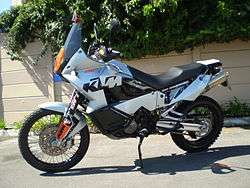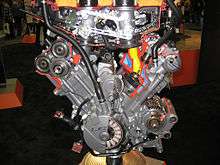KTM 950 Adventure
 | |
| Manufacturer | KTM |
|---|---|
| Also called | KTM LC8 Adventure |
| Production | 2003-2005 |
| Successor | KTM 990 Adventure |
| Class | Dual-sport motorcycle |
| Engine | 942 cc 75° V-twin[1] |
| Bore / stroke | 100 mm × 60 mm (3.94 in × 2.36 in) |
| Compression ratio | 11.5:1 |
| Top speed | 215km/h |
| Power | 102 bhp (76 kW) @ 8,000 rpm |
| Torque | 97 N·m (72 lbf·ft) @ 6,000 rpm |
| Ignition type | Denso CDI |
| Transmission | 6 gears |
| Frame type | Open cradle, chrome-molybdenum steel tubes with Aluminium subframe |
| Suspension |
Front: WP USD 4860 MXMA (damping and rebound adjustable) 48 mm (1.9 in) diameter Rear: WP Progressive Damping System (PDS) shock absorber with adjustable hydraulic preload, rebound, separate low and high speed compression damping. |
| Brakes |
Front: 2 x Brembo perforated brake disks, 300 mm (12 in) floating calipers Rear: 1 x Brembo disk 240 mm (9.4 in) with floating caliper. |
| Tires |
Front: 90/90 R21 Rear: 150/70 R18 |
| Rake, trail | 26.6°/ 119 mm (4.7 in) |
| Wheelbase | 1,570 mm (62 in) ± 10 mm (0.39 inch) |
| Seat height |
2003/2004: 880 mm (35 in), |
| Weight |
206 kg (454 lb) (dry) |
| Fuel capacity | 22 L (4.8 imp gal; 5.8 US gal) (including 4 L (0.88 imp gal; 1.1 US gal) reserve) |
| Oil capacity | 3.3 L (0.73 imp gal; 0.87 US gal) |
| Fuel consumption | 5.5 to 10 L/100km (43 to 24 MPG) |
The KTM 950 Adventure is a Dual-sport motorcycle that was produced in Austria by KTM. The bike is powered by a liquid cooled, four-stroke, DOHC 942 cc 75° V-twin engine, producing around 102 bhp (76 kW).
History
The story of KTM 950 Adventure has started in 1992. That year, a one-off special called the Bepono, built for the German BoTT series by two engineering students by combining a pair of cylinders from a KTM LC4 single on a special crankcase, was displayed on the KTM stand at the IFMA Show in Cologne.
That was just a teaser, though - as was the second time around in 1996, when it was revealed that the Stuttgart-based design office Kraft Technik, had been commissioned by KTM to produce a design for a V-twin Hard Enduro, possibly using the 60-degree V-twin RSV900 Rotax engine at that time developing for Aprilia. The Italian company however refused to share it with their Austrian neighbours. Another alternative for KTM was the Swedish Folan 60-degree V-twin motor which already existed, however it was also aborted once KTM had been successfully floated on the stock market.[2]
In early 1998, as the company grew in strength and the need to expand its single-cylinder range with a twin-cylinder product line, new V-twin became a priority. Chief engineer Wolfgang Felber made preliminary studies of twin-cylinder engine formats and vehicle concepts.

By August 1998 the decision was made to go with a 75-degree V-twin design, but with special emphasis on light weight and, especially, compact build. To do so, KTM decided to assume the entire R&D process themselves in-house, and hired Claus Holweg as Project Manager from their Austrian rivals, Rotax.
The new engine called LC8 was complete and had its first dyno run on August 11, 1999 in exactly 12 months from the start.
After the successful engine development the time came to design the body of 950 Adventure.
Development and management departments of KTM put designers and model makers together to set a concept. The final prototype’s design was complete by Kiska, the design partner of KTM, and presented at Munich Motorcycle show in 2000.
After the critical votes, KTM CEO Stefan Pierer decided to reject the first draft of the Adventure except few small details, chassis and engine.
KTM's designers were innovative in defining a never seen design, strained and broken lines with a very angular fairing. In order to help, engineers asked rally pilot Fabrizio Meoni to assist.
In early 2001, engineers quickly built a frame house with ratings defined by Meoni and soon in February 2001, he begins Adventure testing under the real conditions in Tunisia.
Later that year Fabrizio Meoni wins Rallye des Pharaons 2001 following superior victory on the Dakar in 2002, confirming that 950 Adventure is ready.
The nearly final form of the 950 Adventure was formally presented in at the 2003 Intermot Motorcycle show. Mass production of the LC8 begins in February 2003
Suspension
Front and rear suspensions were made by White Power (WP). Front suspensions (also known as forks) allow compression adjustment at the bottom as well as damping adjustments at the top of the forks. Spring preload can be adjusted by removing the top cap of the forks.
Rear suspension (shock absorber) has rebound adjustment at the bottom of the shock. High/low speed dampening are adjustable using a clicker dial and a 14mm hex at the top. It is worth noting that High/Low speed dampening are referring to speed of compressing the spring, not speed of the motorcycle.
Rear shock on all adventure models of 950 and 990 have hydraulic preload adjustment accessible with a knob on the left side of the motorcycle. KTM 950 Super Enduro version has a mechanical large nut compressing the spring instead.
Suspension Travel
Front and rear suspension were changed by KTM through the years it was in production. Seat heigh and ground clearance were subsequently reduced from 2003 model and new year. Some future models of successor KTM 990 Adventure saw increased suspension travel.
| Year | model | Suspensions travel | Seat Hight, unloaded | Ground clearance, unloaded |
|---|---|---|---|---|
| 2003 | 950 Adventure | 230 mm (9.1 in) | 880 mm (35 in) | 281 mm (11.1 in) |
| 2003 | 950 Adventure S | 265 mm (10.4 in) | 915 mm (36.0 in) | 316 mm (12.4 in) |
| 2004 | 950 Adventure | 230 mm (9.1 in) | 880 mm (35 in) | 281 mm (11.1 in) |
| 2004 | 950 Adventure S | 265 mm (10.4 in) | 915 mm (36.0 in) | 316 mm (12.4 in) |
| 2005 | 950 Adventure | 210 mm (8.3 in) | 860 mm (34 in) | 261 mm (10.3 in) |
| 2005 | 950 Adventure S | 245 mm (9.6 in) | 895 mm (35.2 in) | 296 mm (11.7 in) |
| 2006 | 950 Adventure | 210 mm (8.3 in) | 860 mm (34 in) | 261 mm (10.3 in) |
| 2006 | 950 Adventure S | 245 mm (9.6 in) | 895 mm (35.2 in) | 296 mm (11.7 in) |
| 2007 | 990 Adventure | 210 mm (8.3 in) | 860 mm (34 in) | 261 mm (10.3 in) |
| 2007 | 990 Adventure S | 265 mm (10.4 in) | 915 mm (36.0 in) | 316 mm (12.4 in) |
| 2008 | 990 Adventure | 210 mm (8.3 in) | 860 mm (34 in) | 261 mm (10.3 in) |
| 2008 | 990 Adventure S | 265 mm (10.4 in) | 915 mm (36.0 in) | 316 mm (12.4 in) |
| 2009 | 990 Adventure | 210 mm (8.3 in) | 880 mm (35 in) | 261 mm (10.3 in) |
| 2009 | 990 Adventure R | 265 mm (10.4 in) | 920 mm (36 in) | 316 mm (12.4 in) |
| 2010 | 990 Adventure | 210 mm (8.3 in) | 880 mm (35 in) | 261 mm (10.3 in) |
| 2010 | 990 Adventure R | 265 mm (10.4 in) | 920 mm (36 in) | 316 mm (12.4 in) |
| 2011 | 990 Adventure | 210 mm (8.3 in) | 880 mm (35 in) | 261 mm (10.3 in) |
| 2011 | 990 Adventure R | 245 mm (9.6 in) | 905 mm (35.6 in) | 301 mm (11.9 in) |
| 2006 | 950 Super Enduro R | 250 mm (9.8 in) front 255 mm (10.0 in) rear | 965 mm (38.0 in) | 330 mm (13 in) |
| 2008 | 950 Super Enduro R | 250 mm (9.8 in) front 255 mm (10.0 in) rear | 965 mm (38.0 in) | 330 mm (13 in) |
Modifications
| Year | 950 Adventure | 950 Adventure S | Changes[4] |
|---|---|---|---|
| 2003 | Grey-Black | Orange | N\A |
| 2004 | Grey-Black, Black, Orange | Blue-Orange colors of Rally Raid Gauloises Team with 'GO !!!!!!!!!!!' slogan |
|
| 2005 | Black, Orange | Blue-Orange, but 'GO !!!!!!!!!!!' slogan removed |
|
See also
Other large dual-sport motorcycles :
References
- ↑ Yossef Schvetz (November 8, 2000). "First Look: KTM LC8 Adventure". Archived from the original on April 15, 2007. Retrieved 2011-04-05.
- ↑ Alan Cathcart. "Not Like The Others". Retrieved 2011-04-05.
- ↑ Based on information published by KTM in Repair Manual 2003-2013 (Edition: 12/2012 - Art-No. 3.206.142-E) and each year model's specific Owner's Manual. Owner's Manuals on KTM950.info
- ↑ "Evolution des Modéles". Retrieved 2011-04-03.
External links
 Media related to KTM Adventure at Wikimedia Commons
Media related to KTM Adventure at Wikimedia Commons